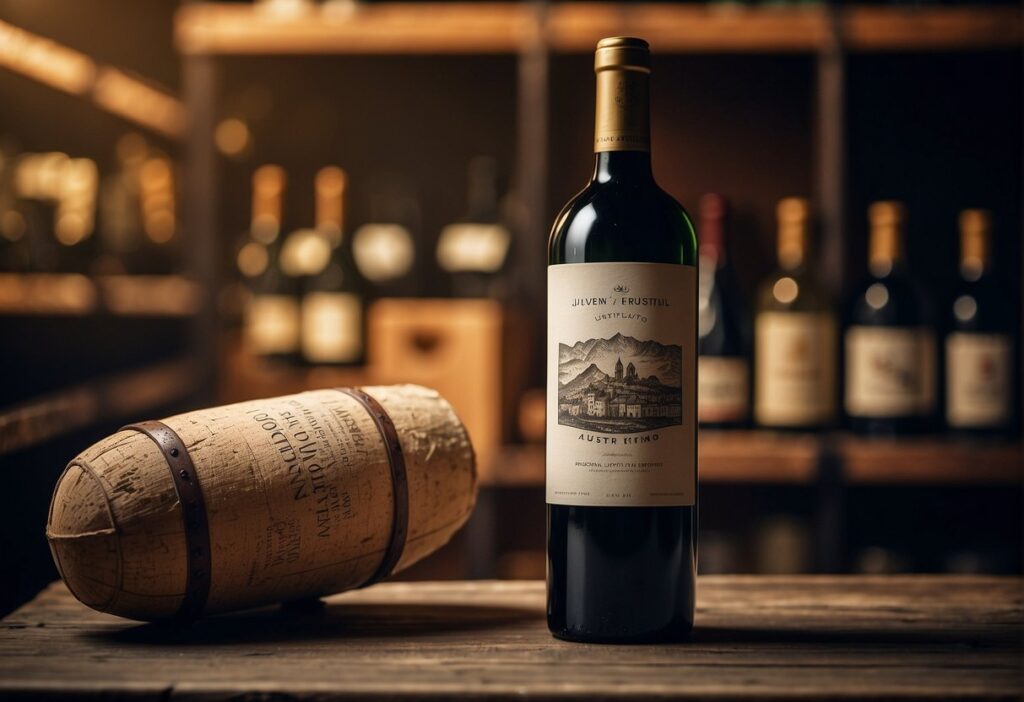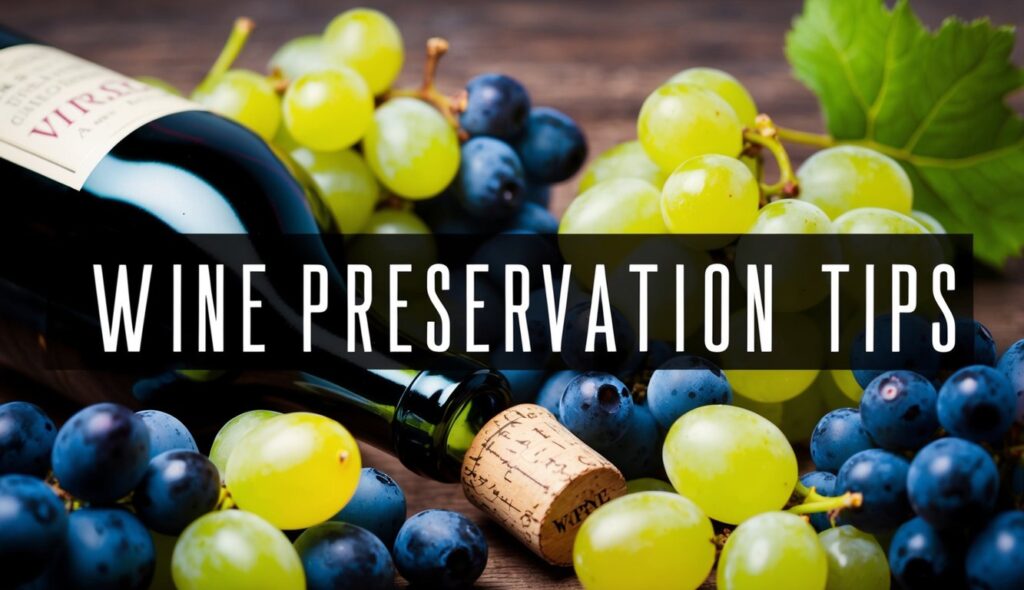Storing red wine correctly can enhance its flavor and ensure it remains enjoyable for longer periods. To store red wine, you should keep it at a consistent temperature. Ideally, the temperature should be between 45°F and 65°F. You should also keep the wine away from light and vibrations. This helps maintain its taste and quality, especially if you plan to store it for extended periods.

When you open a bottle of red wine, the task becomes slightly different. It’s important to replace the cork tightly and store it in a cooler area to slow down oxidation. For short-term storage, consider using a wine fridge to keep the wine fresh and preserve its taste. Check out these tips on how to store an opened bottle of red wine properly to enjoy its flavors even after a few days.
Proper storage not only maintains the taste but also can improve the quality of the wine over time. Investing in a wine rack can be beneficial as it allows bottles to lie on their side. This keeps the cork moist and prevents it from drying out. This is crucial for long-term storage. Learn more about the best ways to store unopened red wine and what factors can affect its longevity by visiting How to Properly Store Red Wine.
Understanding Wine Storage Basics
When storing red wine, temperature, humidity, and oxidation play critical roles. These factors can impact the wine’s flavor and longevity.
Importance of Temperature Control
Maintaining the right temperature is essential in wine storage. Red wines should ideally be stored between 55 to 65°F. Keeping wine within this range preserves its quality and prevents spoilage.
Avoid places with frequent temperature swings as they can cause the liquid inside the bottle to expand and contract. This might push the cork out, leading to air exposure and spoilage. A wine fridge or cooler is a valuable investment to ensure consistent temperatures.
Role of Humidity in Wine Preservation
Humidity significantly influences how well wine ages. A humidity level around 70% is recommended. This prevents corks from drying out, which can allow air to enter the bottle and spoil the wine. When the cork is moist, it expands to fit tightly, minimizing oxidation risk.
Too much humidity can lead to mold growth, possibly affecting the bottle label and cork. Regularly monitoring humidity helps create the optimal conditions for wine preservation.
Effects of Oxidation on Red Wine
Oxidation occurs when wine is exposed to air, leading to undesirable flavor changes. This process can alter the wine’s taste, making it taste stale or like vinegar over time.
Ensure airtight seals on bottles to avoid oxidation. Storage methods like using a wine vacuum pump can reduce air exposure. Monitoring these factors helps maintain the wine’s integrity and prolong its shelf life.
Short-Term Versus Long-Term Storage
Properly storing red wine is essential to maintaining its quality and taste. Understanding the differences between short-term and long-term storage is crucial for wine enthusiasts looking to enjoy their collection over time.
Best Practices for Short-Term Storage
When storing red wine for a short period, stability is key. Keep the wine at a stable temperature—between 50°-59°F is ideal. Avoid exposing the wine to temperature fluctuations, which can alter the flavor and composition. It’s best to avoid direct sunlight and bright lights, as they can degrade wine over time.
Humidity also plays a significant role in maintaining the wine’s quality. Aim for a humidity level around 50% to 80% to prevent the cork from drying out, which can let air into the bottle and spoil the wine.
You might store red wine in a dark, cool place, like a closet or pantry. For more fine-tuned control, a wine-specific fridge can help maintain the ideal conditions for short-term storage. Such practices will ensure that your wine remains enjoyable until you’re ready to savor it.
Strategies for Long-Term Wine Storage
Long-term wine storage requires more attention to detail to preserve the wine’s aging potential. A constant temperature, typically between 53° and 57°F, is recommended. This range minimizes the risk of spoilage and ensures the wine ages as intended.
Light exposure should be minimal, so storing wine in a dark location, like a basement, is beneficial. Also, reduce vibrations, which can disturb the wine’s sediment and impede the aging process. Keep bottles horizontally to ensure corks stay moist and airtight.
Incorporating suitable humidity levels is vital. Ideally, maintain a humidity level between 50% and 80%. This prevents the cork from drying and allows the wine to mature gracefully. Strategies like these provide the perfect environment for your valuable collection.
Selecting the Right Storage Solutions

Choosing the correct storage method for red wine can enhance its flavor and longevity. Important aspects include temperature control, humidity levels, and protection from light.
Wine Fridges and Coolers
Look for wine fridges or coolers with reliable temperature settings. They maintain a stable environment, ideal for storing red wine between 52-58 degrees Fahrenheit. Opt for models that have dual temperature zones if you also store white wine. This helps manage different wine types without compromising on storage quality.
Check for features like energy efficiency and low vibration levels. Less vibration means preserving the wine’s flavor profile. Many wine coolers have UV-resistant glass doors, blocking harmful light and further protecting your wine. Investing in a quality wine fridge can significantly improve your wine’s aging process and taste.
Constructing a Wine Cellar
Building a wine cellar provides a dedicated space for long-term storage. You should maintain temperatures around 55 degrees Fahrenheit with humidity levels between 55% to 65%. This prevents corks from drying out, which could spoil the wine. Including a dehumidifier can help maintain these conditions.
You’ll want to ensure low light exposure and minimal vibration in your wine cellar. Consider options like insulated doors and proper shelving to avoid unwanted movements. Shelving should allow each bottle to lay horizontally to keep the cork moist. Construction costs can vary, so plan carefully to fit your budget and wine collection needs.
Alternatives for Wine Connoisseurs
There are other ways to store wine if fridges or cellars aren’t feasible. Use a dark, cool closet with stable temperatures. Add a small dehumidifier to manage humidity levels if needed. Consider wine preservation systems for opened bottles, which can keep wine fresh for several days or even weeks.
Wine racks with covers provide some protection from light and temperature fluctuations. These solutions aren’t as controlled as fridges or cellars but can work in a pinch. Remember, consistency in temperature is key, so avoid placing bottles near heat sources or in direct sunlight to preserve their flavor and quality.
Preserving Open Wine Bottles

When you open a bottle of wine, preserving its quality is essential. Various tools and methods can help maintain taste and prevent spoilage. Vacuum pumps and wine stoppers offer solutions, while best practices can extend the life of leftover wine.
Utilizing Vacuum Pumps and Wine Stoppers
To keep an open wine bottle fresh, consider using a vacuum pump. It removes air from the bottle, slowing down oxidation. Oxidation affects taste, so minimizing air exposure is important. A wine stopper serves as a seal to prevent new air from entering, further protecting the wine’s flavor. For sparkling wines, a Champagne stopper is ideal to maintain fizziness by locking in the bubbles.
These tools are easy to use and effective for short-term storage. Look for vacuum pumps with reusable stoppers for sustainability. By using a combination of a vacuum pump and a proper stopper, you can enjoy the same quality when you return to your wine.
Best Practices for Leftover Wine
Storing leftover wine correctly can make a big difference. Keep your opened bottle in a cool environment to slow down chemical changes. Refrigeration is recommended even for red wines. If possible, transfer the wine to a smaller bottle to reduce air contact.
Avoid storing wine near heat sources or direct sunlight. Consistent temperature is key; sudden changes can ruin the taste. Always recork the bottle using the stained side of the cork, as it’s already been in contact with the wine.
Following these strategies helps maintain the quality of open bottles, allowing you to savor every glass.
Cultivating a Wine Collection

Building a wine collection involves selecting wines with rich flavors and proper storage techniques. Focus on quality over quantity to ensure a diverse collection. Consider factors like wine varietals and serving temperatures to enhance your enjoyment.
Choosing Wines for Your Collection
When you’re starting a wine collection, consider a mix of different varietals like Pinot Noir, Chardonnay, and Merlot. Opt for a balance between organic wine and traditional options to experience a broad spectrum of flavors. Focus on wines with aging potential, which can develop complex flavors over time, attracting attention from wine connoisseurs.
Pay attention to regions and vintages as they greatly impact wine’s taste and aroma. Look for wines that suit your preference while also considering more unique options for special occasions. It’s also beneficial to include some everyday wines, which can be enjoyed more frequently. Maintain a record of your purchases and tasting notes to track your evolving tastes and help guide future selections.
Understanding Serving Temperature
The right serving temperature brings out the best in a wine’s aroma and flavor. For red wines like Pinot Noir, a slightly cooler temperature of around 55°F to 65°F is ideal. This temperature range allows the flavors to unfold without overwhelming your palate.
A wine-specific fridge can help control temperature fluctuations, making it easier to achieve the right serving conditions. For white wines, cooler temperatures around 45°F to 50°F are appropriate.
Proper serving temperatures not only enrich your tasting experience but also highlight the unique characteristics of each wine in your collection.
Storing wines correctly also helps preserve their quality as you build your collection. By paying attention to these details, you ensure that each bottle is at its best when you’re ready to pour a glass.

